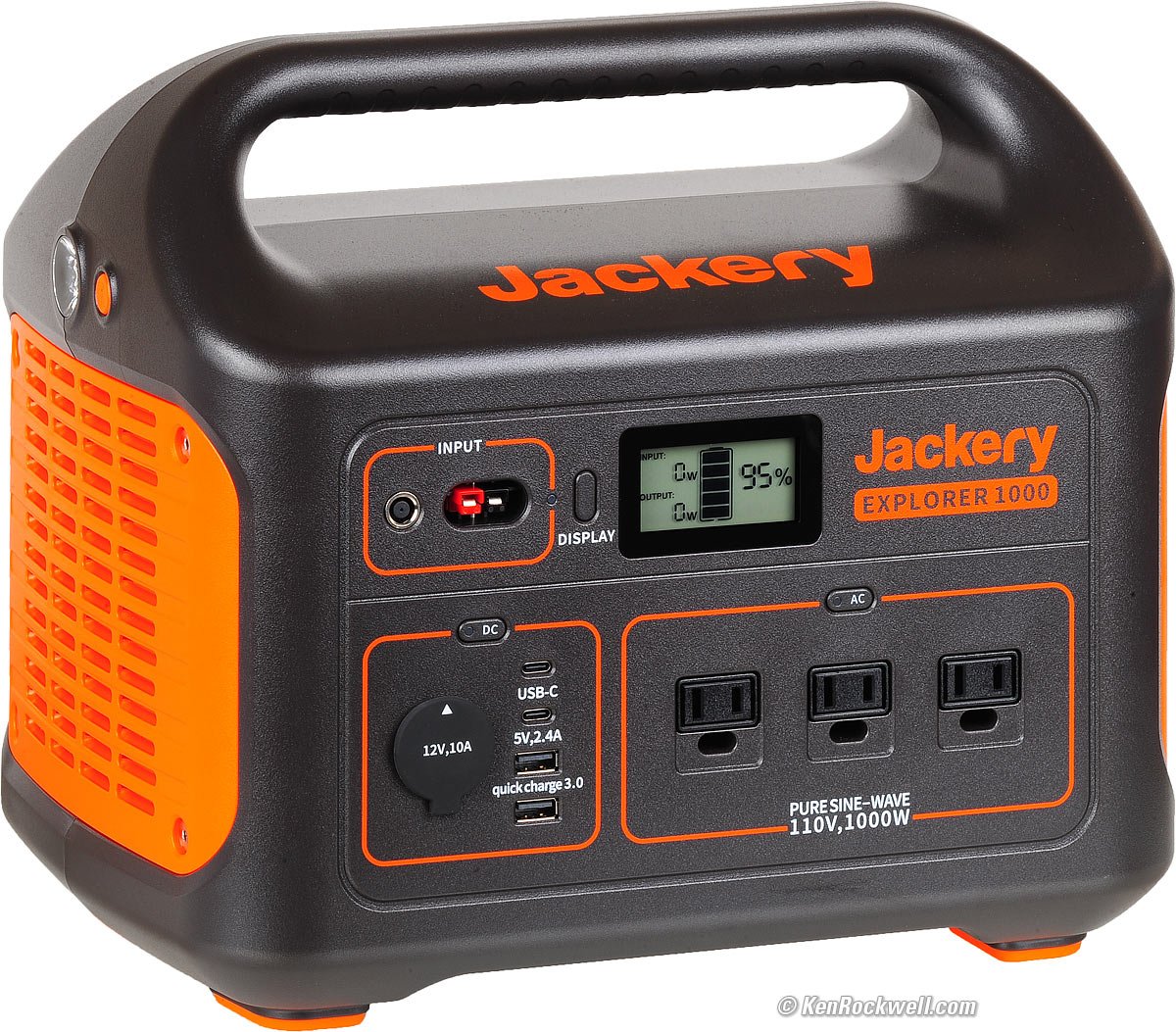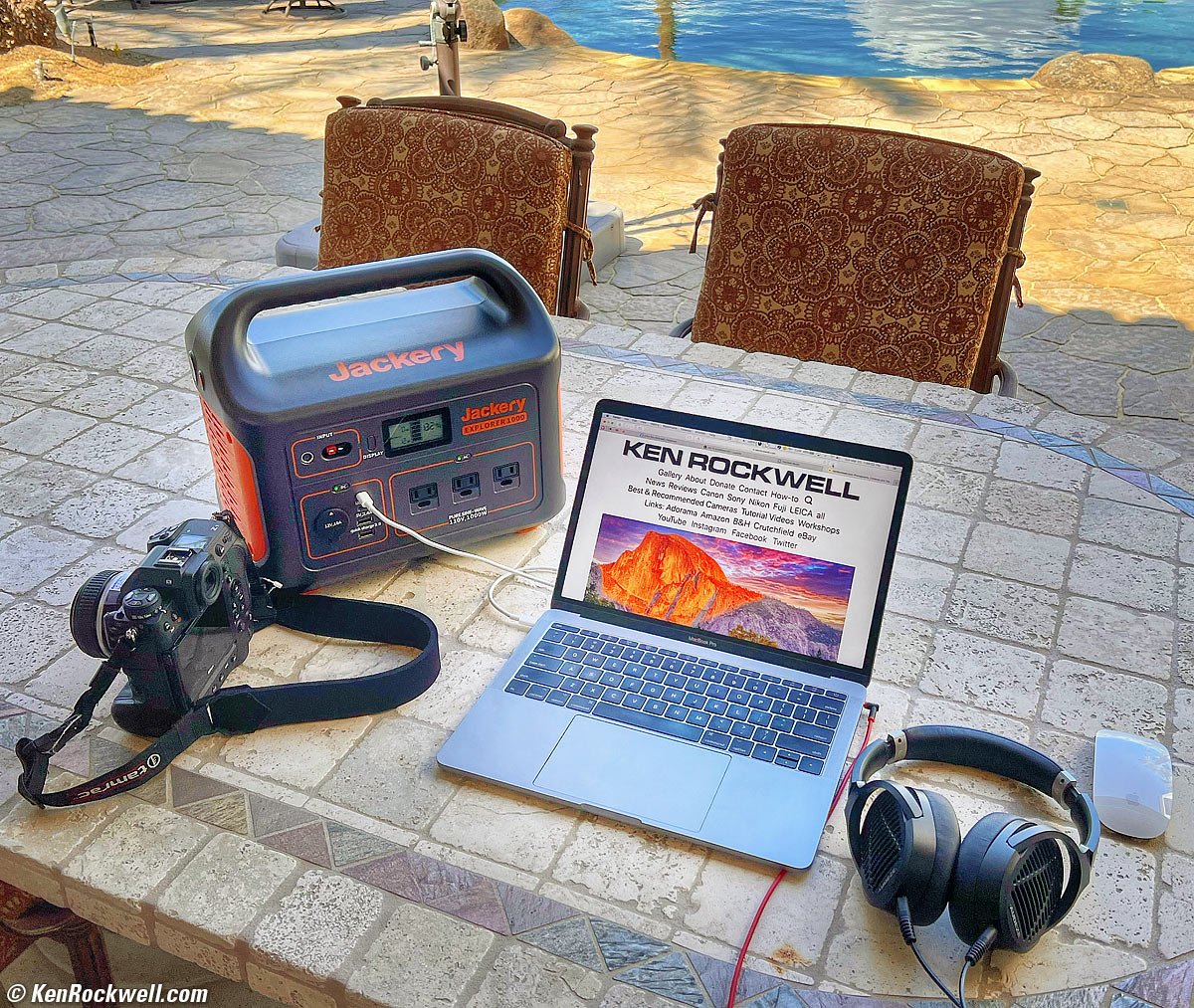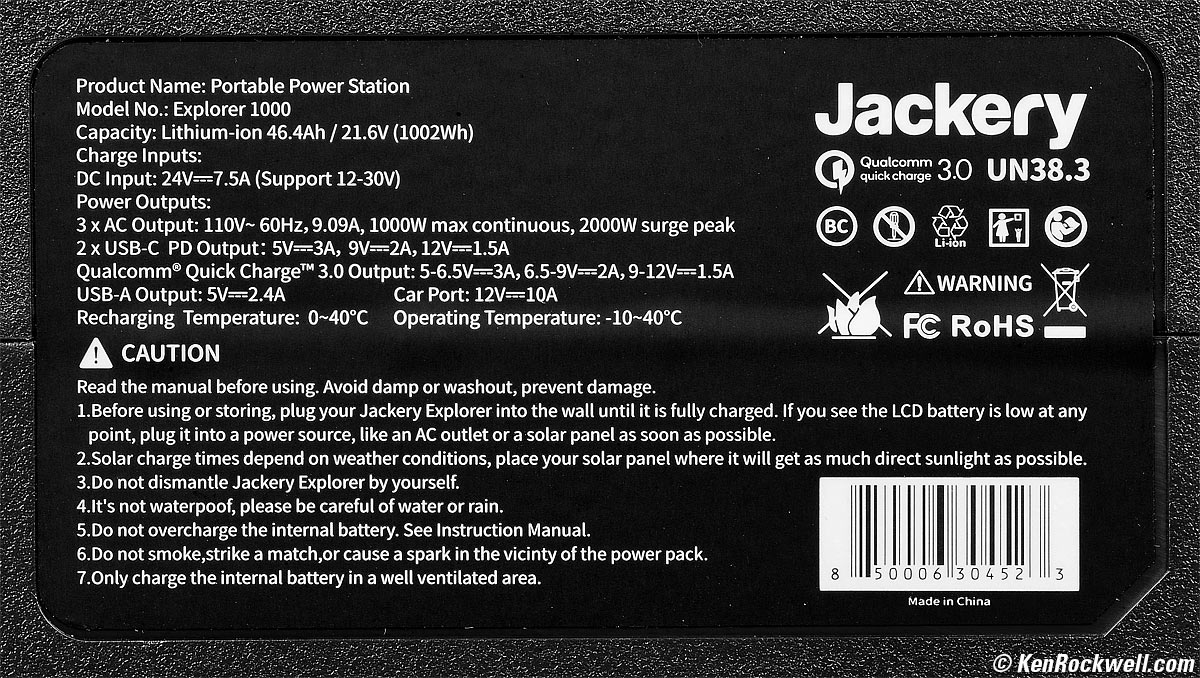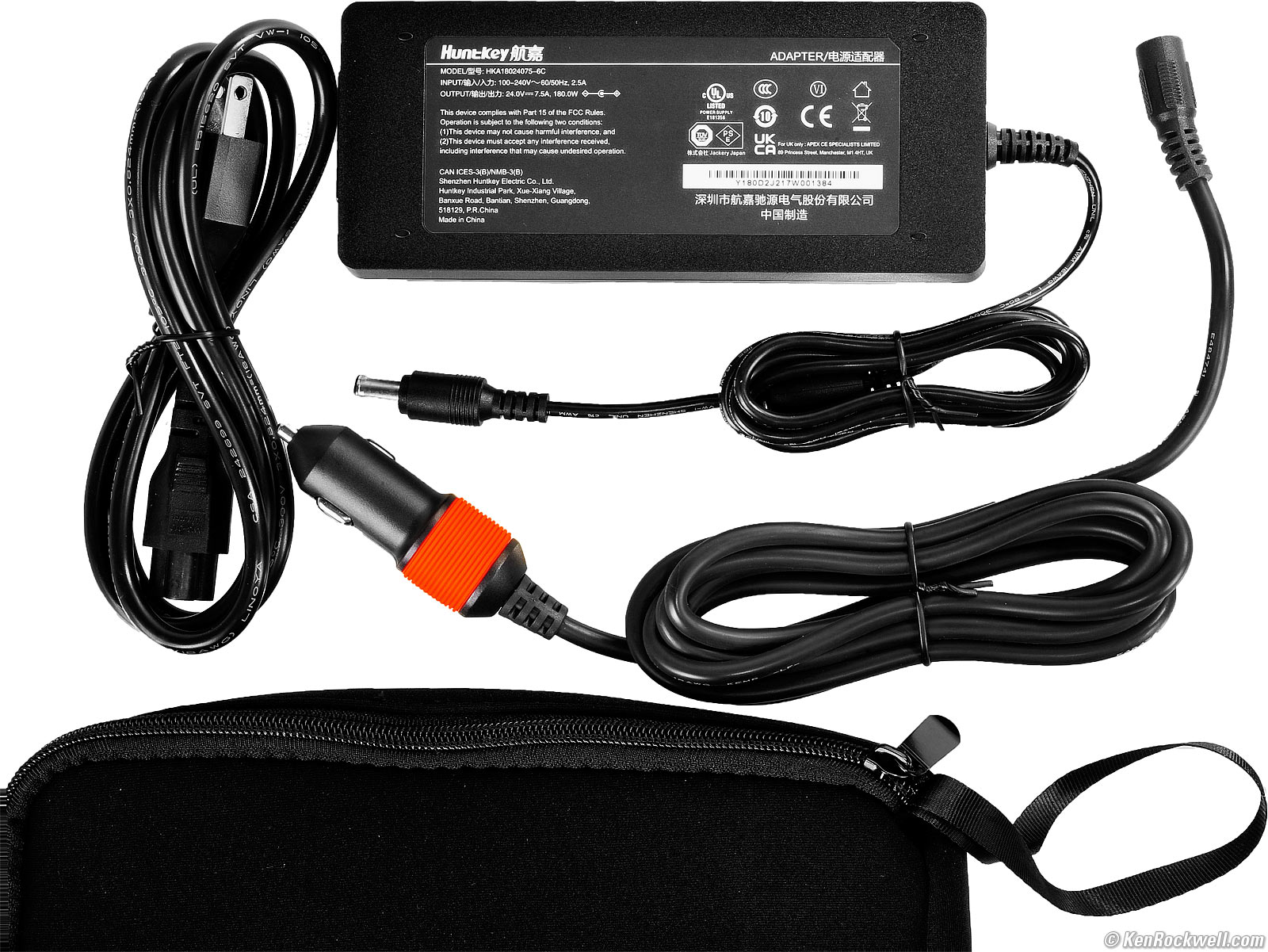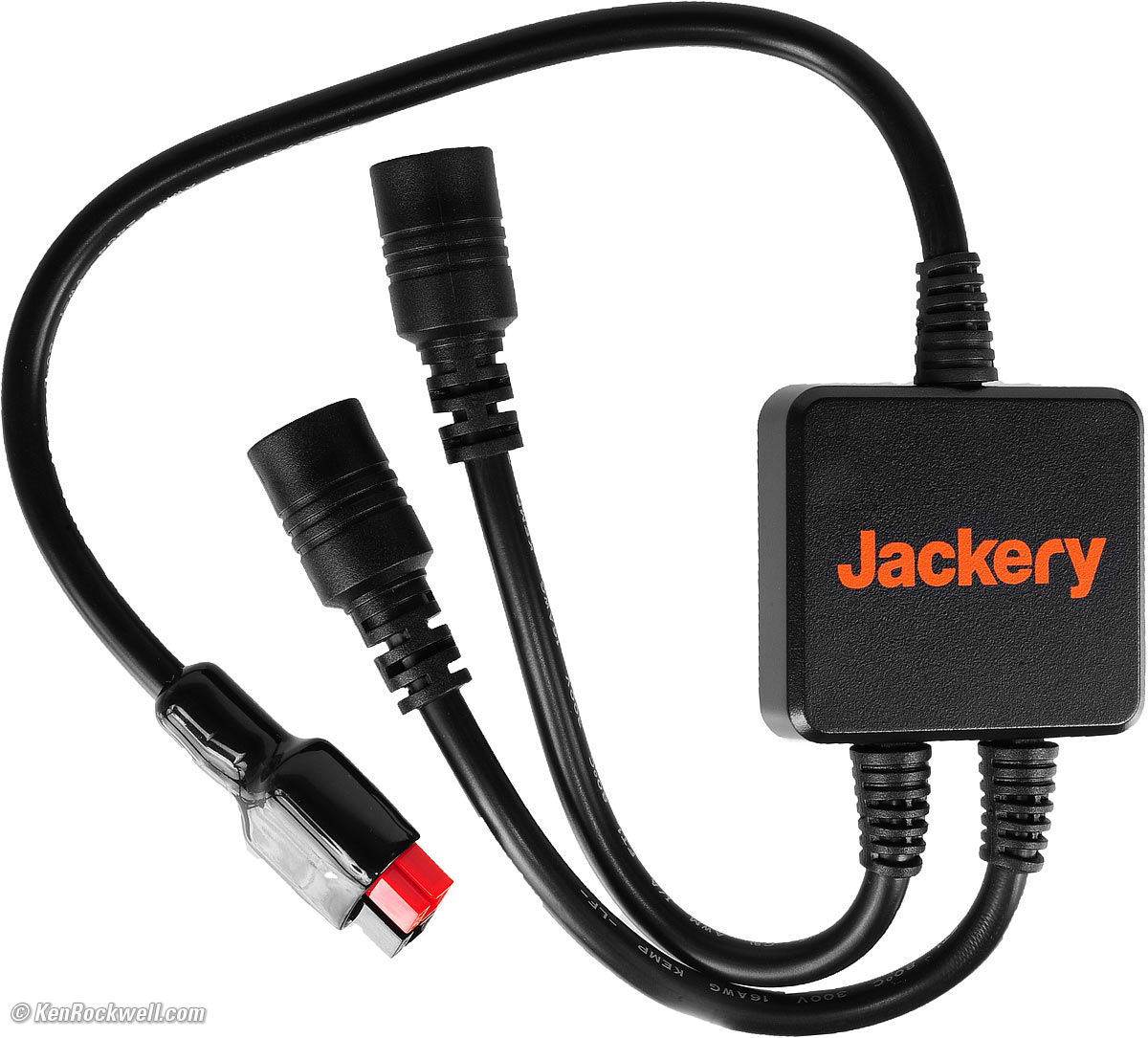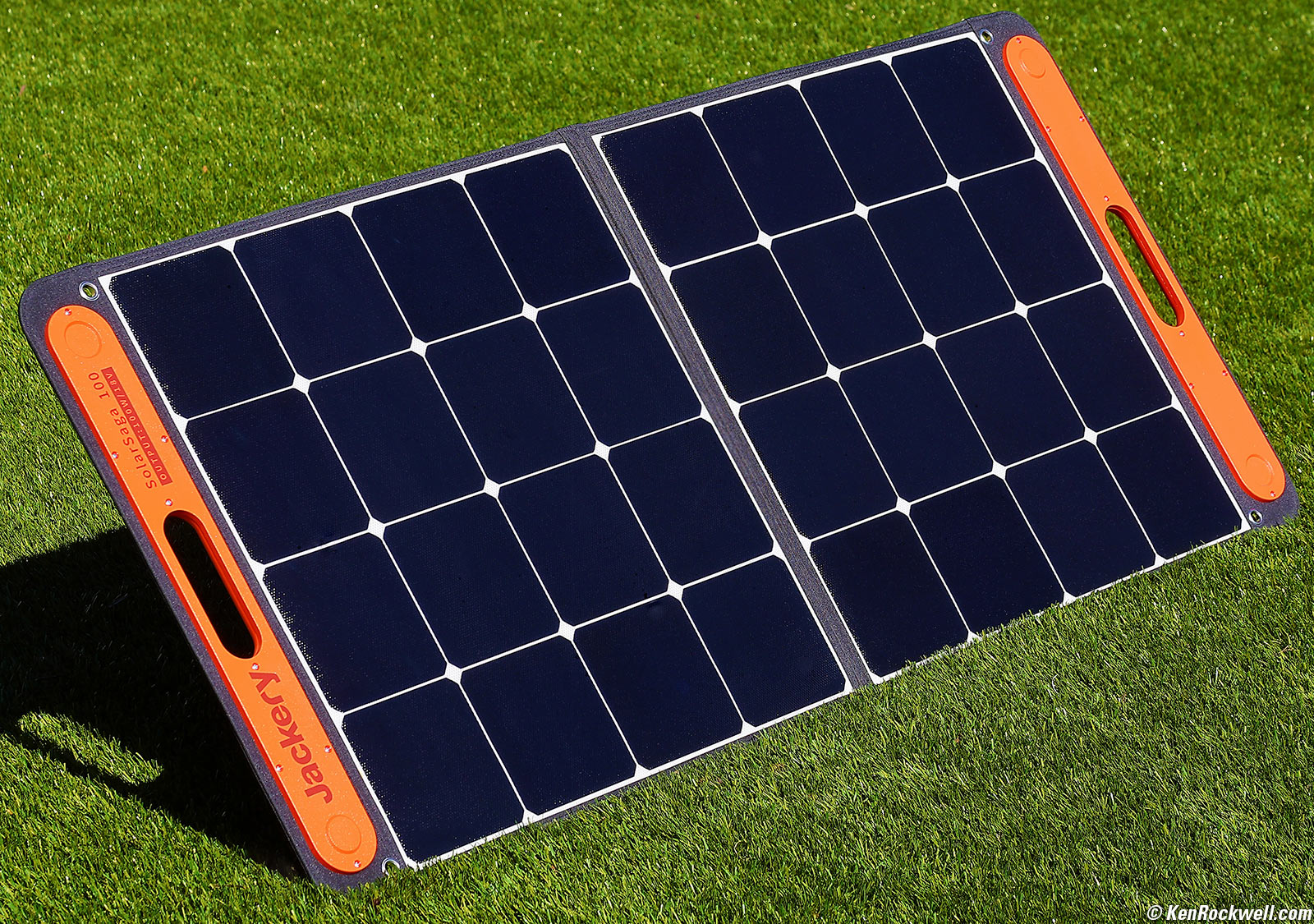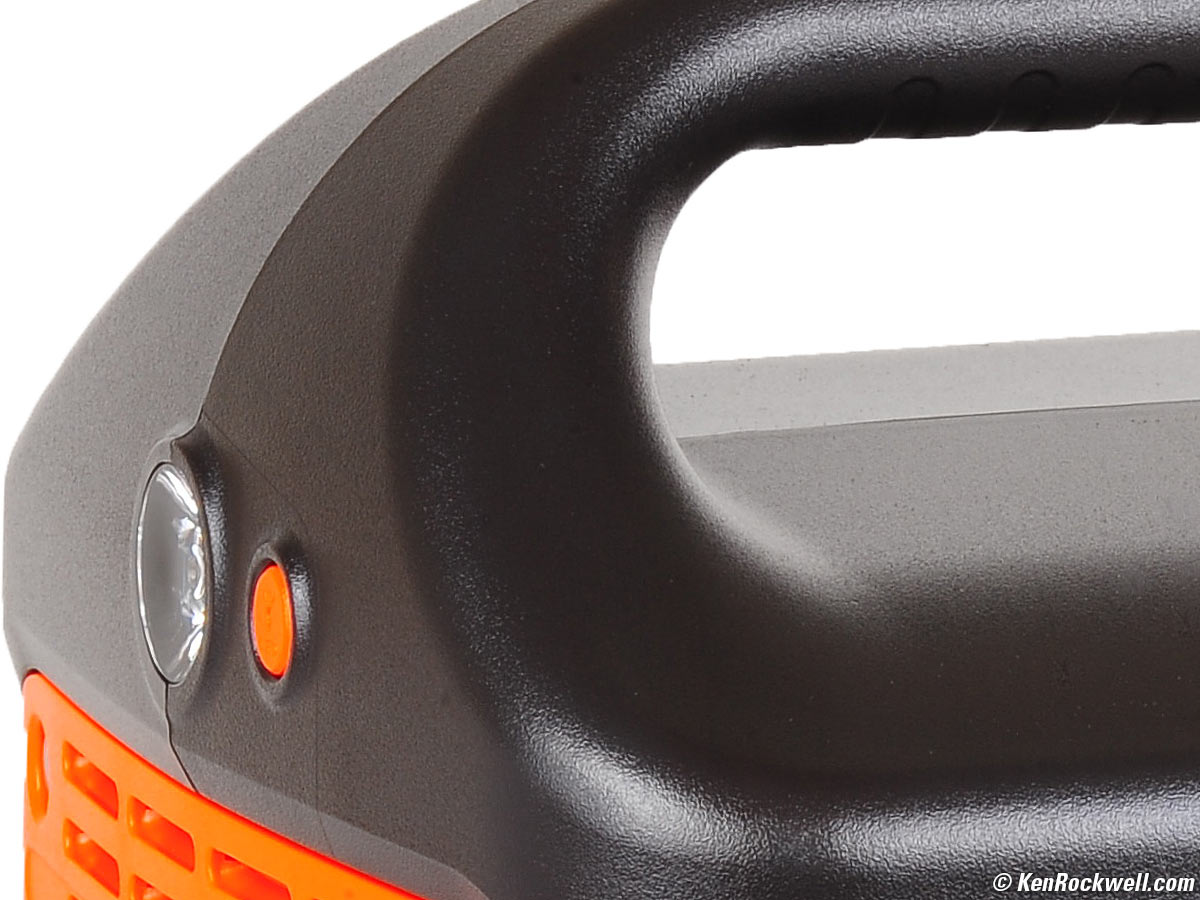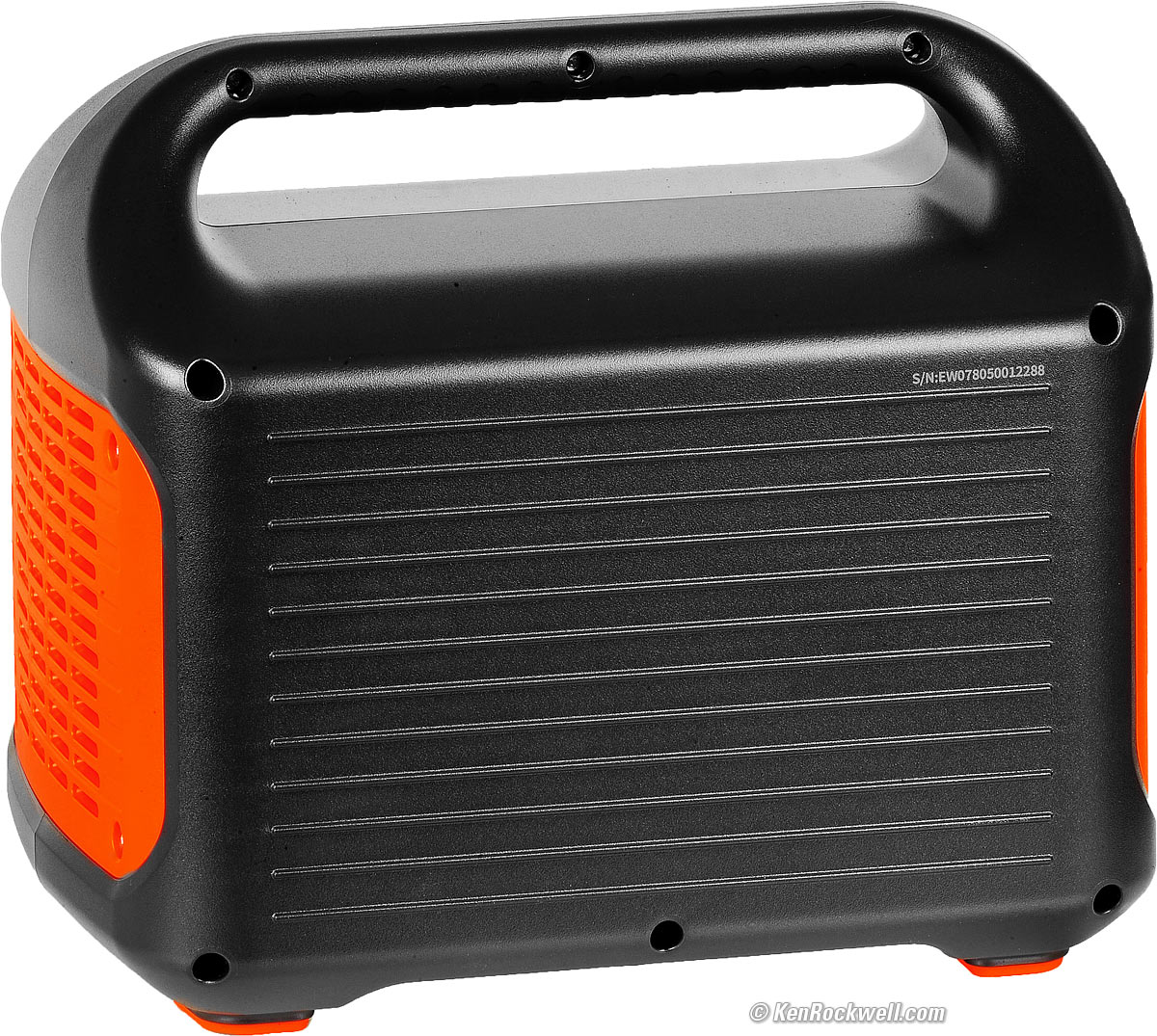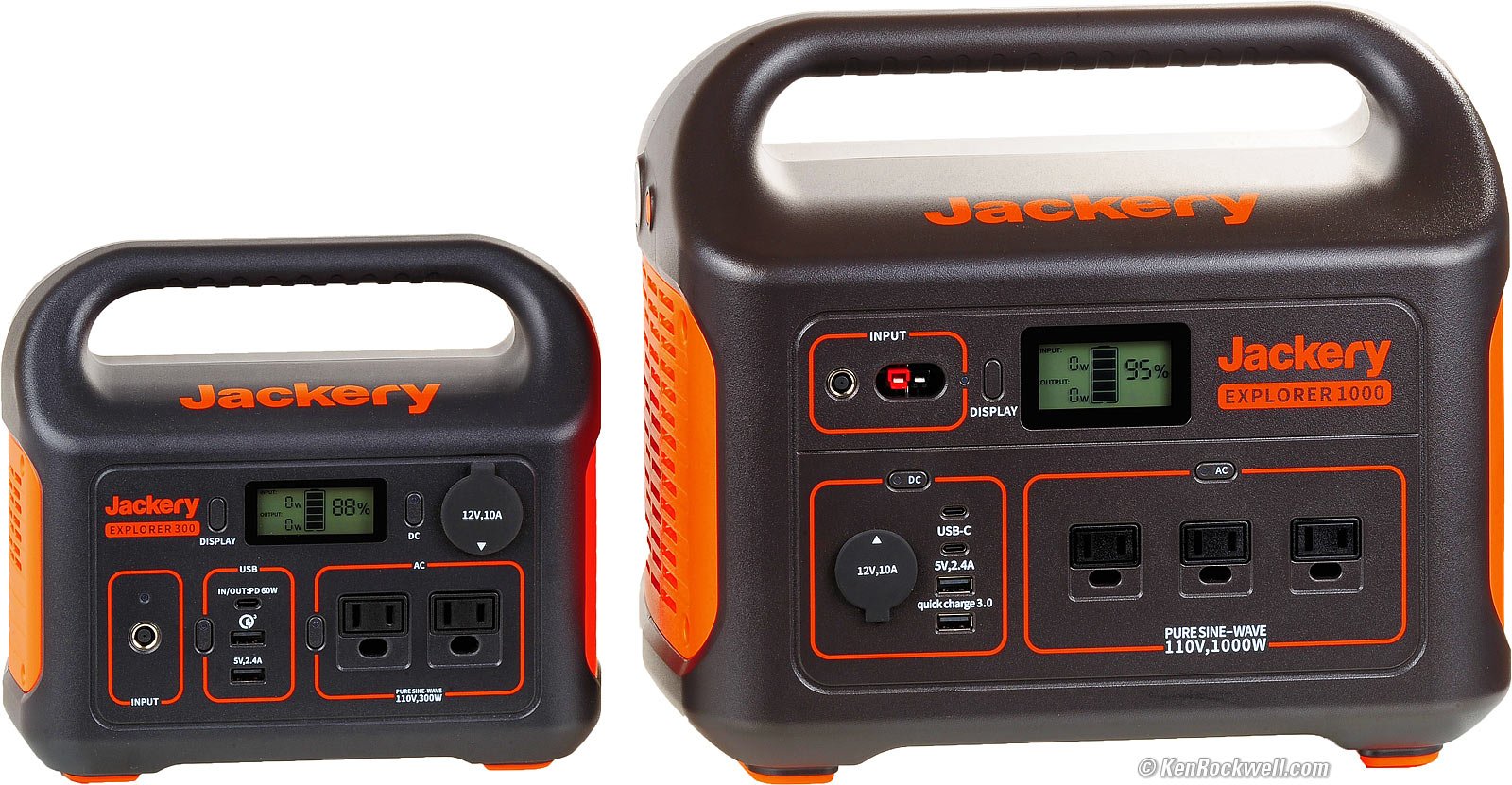Jackery Explorer 1000 Power Station & Solar Generator
1 KWh Li-ion battery with 1 KW AC, 12V 10A DC, 18W USB-C PD, 12 & 18 W USB-A Outputs
Specifications Optional Accessories
Jackery Explorer 1000 (22 pounds/10 kg, $999.99). bigger. I got mine from Amazon. I'd also get it at eBay if you know How to Win at eBay.
The Jackery Solar Generator 1000 set includes two SolarSaga 100W solar panels along with this Explorer 1000 Power Station and a special adapter to connect both panels at the same time.
This all-content, junk-free website's biggest source of support is when you use those or any of these links to approved sources when you get anything, regardless of the country in which you live. Thanks for helping me help you! Ken.
March 2022 Better Pictures Jackery Canon Nikon Sony Fuji All Reviews
Introduction top
Specifications Optional Accessories
|
|
The Jackery Solar Generator 1000 has enough power to run my entire office and editing suite, or my studio strobes and related gear for use in the field or studio, and enough battery capacity to run any of this about all day.
A power station is a big power bank. It's a big battery with inverters to provide whatever sort of power you'd like. You can use whichever outputs you like at the same time; each section has its own switch.
You charge through either the 7.9 × 0.9mm circular or Anderson DC inputs on the left (only one at a time) with the included AC-to-DC adapter, the included 12V DC car charging cord or optional solar panels (two included with the Jackery Solar Generator 1000 set).
Charge this power station with a solar panel and the combination is called a solar generator. It's much bigger than a power bank, and it's still much more portable than any gasoline generator.
Unlike a gasoline generator, it's completely silent and safe to use indoors. It's just a battery.
The solar panels charge it in several hours. It's just as fast as plugging it in the wall, and solar power is free.
You don't want to leave your valuables sitting outside to charge directly from a solar panel, so charge this by day and then charge and run everything later from the power station.
You can use this while it's charging. You might want extension cord(s) if you want to work away from the solar panel, or get more than one power station and run from one while the other is charging.
You can charge at school, in your car or office during the day and then use the power at home at night.
Charge in the hotel or your RV each night and run everything from it on location all day, or just keep it charged at home for emergency power. Charge from solar or OPP (other people's power) and your power is free!
For my light-duty uses, running my MacBook Pro and charging my cameras, iPhones and iPads, a couple of hours of charge provides for days of heavy use, so I can charge whenever I like and run from the power station most of the time.
Its battery is big enough (1 KWh or "270,000 mAh" in power bank terms) that I have clocked that it can charge and run my MacBook Pro for about 48 hours of hard all-day Photoshop and web development use with numerous card readers and peripheral drives! That's a week or more of full-time heavy professional use, or weeks of more of rational use like just web browsing. With casual use of just my MacBook Pro as shown here it ought to run about 90 hours just from the Explorer 1000:
Jackery Explorer 1000 running my MacBook Pro with Magic Mouse. (Nikon Z9 and Audeze LCD-1 on ride-along today.) bigger.
MacBook Pros usually have plenty of juice to run all day, however an advantage to this power station is I can run fast and hard without worrying about screen brightness, processor loads or even bothering to check any battery gauges.
My Explorer 1000 easily drives my complete desktop system with a 55" 4K monitor, numerous external HDDs and SSDs and optical drives and a full complement of class A and class AB professional audio monitors and biamplified powered subwoofers, DACs and crossovers. It runs all this for about 4~5 hours from its AC outputs. Of course my power-hungry pro audio system uses much of the power, as does my huge 55" monitor; the computer and drives use a small fraction.
This Explorer 1000 is perfectly happy driving my big, fat American-made 500 watt-second Novatron studio strobe power pack both in my studio and in the field, complete with its modeling lights. The Explorer 1000's fan blows a bit after each shot because of the spike of power drawn by the strobe's power pack after each shot.
My Explorer 1000 easily runs all the Luxli LED lights in my video studio (two Timpani and one Cello), as well as my TASCAM DR100 Mk II audio recorder and phantom-powered microphones. With the Timpani at 67% and the Cello at 35%, everything draws only 125W total. Be careful; the Explorer 1000's internal fan may turn on if needed after a while, so keep it away from your microphones.
I love using this because it has every kind of power I need. I just grab-and-go to power or charge anything without having to find the right charger and then finding a wall outlet and/or extension cord.
It has a huge battery. It probably can run a month just charging mobile devices so I only might only have to charge the Explorer 1000 once a month, or whenever it or free power are convenient.
I got my Explorer 1000 from Amazon. I'd also get it at eBay if you know How to Win at eBay.
Good intro top
 Solid, reliable and well-regulated power at all loads in a compact package.
Solid, reliable and well-regulated power at all loads in a compact package.
 It runs calmly and never does anything screwy when overloaded, connected or disconnected. It's a mature design with no surprises.
It runs calmly and never does anything screwy when overloaded, connected or disconnected. It's a mature design with no surprises.
 While "only" rated 1 KW (1,000 W) continuous, it is surge rated to 2 KW (2,000 W) and can drive overloads for various amounts of time without a problem.
While "only" rated 1 KW (1,000 W) continuous, it is surge rated to 2 KW (2,000 W) and can drive overloads for various amounts of time without a problem.
 While it won't drive an electric heater or hair dryer very long at a full 1.5 KW (1,500 W) setting, set a hair dryer to medium heat and it should be fine. Of course there isn't much battery life at full load (less than an hour), but you can do it. More at Usage.
While it won't drive an electric heater or hair dryer very long at a full 1.5 KW (1,500 W) setting, set a hair dryer to medium heat and it should be fine. Of course there isn't much battery life at full load (less than an hour), but you can do it. More at Usage.
 Charges quickly from SolarSaga 100W solar panels or other sources.
Charges quickly from SolarSaga 100W solar panels or other sources.
 Charges from just about anything from 12 to 30 V DC: one or more solar panels, the included AC-to-DC adapter, the included 12V DC car cord, or any other DC source like my 12V DC hard drive power supply, so long as you have a 7.9 × 0.9mm plug on the end. More at Charging.
Charges from just about anything from 12 to 30 V DC: one or more solar panels, the included AC-to-DC adapter, the included 12V DC car cord, or any other DC source like my 12V DC hard drive power supply, so long as you have a 7.9 × 0.9mm plug on the end. More at Charging.
 Outputs work fine while charging. Depending on charge and load levels you may either wind up with net charging or net discharging.
Outputs work fine while charging. Depending on charge and load levels you may either wind up with net charging or net discharging.
 Has a basic flashlight on the left side, which ought to run for a month on a charge.
Has a basic flashlight on the left side, which ought to run for a month on a charge.
 The LCD panel is always active while charging or operating, but the backlight always times-out after 15 seconds so you need to be in decent light to read it.
The LCD panel is always active while charging or operating, but the backlight always times-out after 15 seconds so you need to be in decent light to read it.
 Very efficient converters and inverters. The DC or AC inverters each only draw an indicated watt or two at idle.
Very efficient converters and inverters. The DC or AC inverters each only draw an indicated watt or two at idle.
 Idle power draw is so low that leaving any of the outputs active for extended periods won't waste any significant amount of power.
Idle power draw is so low that leaving any of the outputs active for extended periods won't waste any significant amount of power.
 Nice, big, fat rubbery orange feet for use indoors or on granite boulders.
Nice, big, fat rubbery orange feet for use indoors or on granite boulders.
 Display backlight blinks ten times when you hit 20% on discharge to warn you, as well at at 10%.
Display backlight blinks ten times when you hit 20% on discharge to warn you, as well at at 10%.
Bad intro top
 Nothing other than not being free. Works great.
Nothing other than not being free. Works great.
Missing intro top
 No time-till-empty or time-till-charged indicators.
No time-till-empty or time-till-charged indicators.
 Like all power stations, doesn't really work as an uninterruptible power supply because the maximum charge rate is much less than the maximum power output. More at my User's Guide.
Like all power stations, doesn't really work as an uninterruptible power supply because the maximum charge rate is much less than the maximum power output. More at my User's Guide.
 The display LCD is always active while charging or operating, but the backlight times-out 15 seconds after each button-push. There is no way to keep the backlight on continuously.
The display LCD is always active while charging or operating, but the backlight times-out 15 seconds after each button-push. There is no way to keep the backlight on continuously.
 It reads power-in and power-out separately, so if you're using and charging at the same time it doesn't show net battery charge or drain; you'd have to do the math yourself.
It reads power-in and power-out separately, so if you're using and charging at the same time it doesn't show net battery charge or drain; you'd have to do the math yourself.
 Not waterproof.
Not waterproof.
 No case included (does include a case for the charge cords).
No case included (does include a case for the charge cords).
 No storage compartment for small accessories, adapters or plugs.
No storage compartment for small accessories, adapters or plugs.
Specifications top
Specifications Optional Accessories
I got my Explorer 1000 from Amazon. I'd also get it at eBay if you know How to Win at eBay.
Capacity specifications top
1,002 watt hours.
46.4 Ah, 21.6 V.
"270,000 mAh" in power bank terms.
Power Outputs specifications top
110 VAC
1,000 watts continuous.
2,000 watts surge.
12 V DC
10 A.
Nominally 120 W, however since it actually measures 13.4V that could mean 134 W.
USB-C PD
18 watts (up to 12V 1.5A).
USB-A QC 3.0
18 watts (up to 12V 1.5A).
USB-A
12 watts (5V 2.4A).
DC Charging Input specifications top
7.9 x 0.9mm (DC7909) and Anderson DC input jacks.
Only one active at a time.
12 ~ 30 V DC.
7.5 A at 24 V = 180 watts maximum.
Jackery Explorer 1000. bigger.
Auto Shutoff specifications top
No automatic shutoff on DC outputs: the USB or 12V outputs stay on until you turn them off.
Shuts off after 12 hours with less than 10W drawn from the AC outputs.
Size specifications top
11.1 × 13.2 × 9.2 inches HWD.
282 × 335 × 234 millimeters HWD.
Weight specifications top
22 pounds (10 kg).
Quality specifications top
Made in China.
Environment specifications top
Charging
0 ~ +35º C (32 ~ 95º F).
Discharging
-10 ~ +40º C (14 ~ 104º F).
Included specifications top
Included AC power adapter, DC cord to charge from your car's power sockets and their small case. bigger.
Included Jackery Dual Solar Panel Charging Adapter. bigger.
This adapter has two 7.9 × 0.9mm circular input jacks and one Anderson DC output.
It lets you connect two solar panels and prevents them from interfering with each other if one gets less light than the other (if one is in a shadow, for instance). More at Charging.
Warranty specifications top
2 years.
Price, U. S. A. specifications top
March 2022
Explorer 1000 Power Station: $999.99
Solar Generator 1000 set (includes Explorer 1000 Power Station, two SolarSaga 100W solar panels and a special adapter to connect both panels at the same time): $1,549.
Optional Accessories top
Specifications Optional Accessories
I got my Explorer 1000 from Amazon. I'd also get it at eBay if you know How to Win at eBay.
Jackery SolarSaga 100W Solar Panel.
These 100W Solar Panels work great, charging this power station in several hours.
The Solar Generator 1000 set includes the Explorer 1000 Power Station, two SolarSaga 100W solar panels and a special adapter to connect both panels at the same time.
5.5 × 2.1mm to 7.9 × 0.9mm adapter to charge from smaller solar panels or AC adapters.
Measurements top
Specifications Optional Accessories
I got my Explorer 1000 from Amazon. I'd also get it at eBay if you know How to Win at eBay.
Maximum Output Power
It easily meets its rated 1kW AC output.
Even overloaded at 1,100 W it ran at least a minute, and with a 1,500 W overload (a hair dryer set to its maximum) it ran just fine for 16 seconds before calmly shutting off the output.
As far as I checked the DC outputs perform as rated.
More at my Explorer 1000 User's Guide.
AC Output Voltages measurements top
The AC outputs are extremely well regulated, not varying any significant amount, even when deliberately overloaded:
Load |
Output Voltage, RMS AC |
No load |
111.9 V |
77 W |
111.7 V |
195 W |
111.7 V |
421 W |
111.4 V |
450 W |
111.3 V |
735 W |
111.3 V |
788 W |
111.2 V |
1,069 W* |
111.3 V |
1,440 W* |
110.8 V |
1,500 W* |
110.8 V |
* Overloaded, and still well regulated.
AC Overloads measurements top
The AC output delivers 1,100 W for at least a minute. I gave up waiting for it to shut off, it may run much longer but remember you'll have much less than an hour of battery life at these levels.
Delivering 1,500 W the output shuts off after 16.67 seconds.
More at my Explorer 1000 User's Guide.
AC Output Frequency measurements top
I measure 60.26 Hz both unloaded and at 195W, which is close enough for anything modern.
AC Cooling Fan measurements top
The cooling fan usually pops on for a moment when the AC output is first activated, then is off at low loads.
Even at 170 W the fan doesn't usually run, but it will pop on for a moment from time to time.
I'll assume it runs continuously and varies its speed if run at higher loads for longer periods of time; I haven't tried.
Charging Rates measurements top
It indicates 145W charging from the included 24 volt, 7.5 ampere AC to DC adapter.
Using just one Jackery SolarSaga 100W Solar Panel reads 107 W when first put out in the sun, which drops to as low as 87W as the panel heats up and the afternoon dulls the light somewhat. This is normal, panels put out less as they heat up, have more clouds or the sun is lower in the sky. Expect about 100 W in full midday sun and you're good with one 100W panel.
I read a constant 124 W charging from two Jackery SolarSaga 100W Solar Panels with the included dual-panel adapter, even under less than ideal conditions or panel temperature.
While the dual panel system doesn't put out that much more power than just one panel under perfect conditions, the dual-panel's advantage is in real-world conditions of lower light or partially obscured panels, where the dual panels still pump out the same 124 W:
Ambient Light |
Indicated charging power from two panels and included combiner |
Indicated charging power from one panel |
100,000 lux* |
124 W |
107 W |
60,000 lux |
122 W |
72 W |
40,000 lux |
48 W |
|
33,000 lux** |
94 W |
|
4,000 lux |
10 W |
5 W |
2,000 lux |
5 W |
2.5 W |
1,700 lux |
4 W |
2 W |
1,000 lux |
3 W |
1.2 W |
420 lux |
1.5 W |
0.5 W |
* 100,000 lux is about full midday sun on a clear day. Lesser values are as clouds cover or the sun goes down. In this case I'm reading lux values as the sun sets, which ought to have strong infrared components rather than the the same lux values read under overcast (lux is measured as our eye responds to color while solar panels usually have more sensitivity to infrared than our eyes.)
** 33,000 lux is partly cloudy or cloudy bright, and 10,000 lux is bright shade.
As expected for charging Li-Ion batteries, the charge rate ramps down as it approaches 100%. Since the battery is so huge, even a full rated 180W charge is less than a 5-hour rate, so it keeps charging at its maximum rate to around 97% before it starts ramping down.
Once it hits 100% it draws no power.
More at my Explorer 1000 User's Guide.
Charge Times measurements top
It takes about 1,100 Wh to charge any 1,000 Wh Li-ion battery due to inefficiencies in battery chemistry and charge circuits; this is normal. I haven't specifically measured the energy required to recharge this particular power station.
You can do your own math knowing that a full charge should take about 1,100 Wh of energy. Charging at 110 W, expect about a 10-hour charge time from 0% to 100%, but we shouldn't be running it all the way down to 0%.
Mine charges from 0% to 100% in a day, charging at 124 W from two panels, or in about 10 real-world hours of sun throughout the day. Note that Jackery rates charge times for only to 80%; my numbers agree with theirs, which is excellent as many makers of these things lie; Jackery is honest.
We shouldn't be charging from 0% to 100%; it's unhealthy for the battery to discharge that far on a regular basis.
In typical use I can charge from 45% to 100% in about 4 hours (noon-4PM), even on a on a mostly cloudy day with the dual-panel setup. Your results will vary.
More at Charging.
Flashlight measurements top
Flashlight. bigger.
The small light on the side is a pencil beam. It's so easy: just tap the button to turn on or off. You never have to hold it or double-tap or go through annoying flashing modes; it's either ON or OFF. Hallelujah!
It's much brighter than an iPhone (more candlepower), but its beam is much narrower. Each puts out about the same total amount of light (lumens).
It's dimmer than an iPhone to the sides; the 180º floodlight of an iPhone does a better job of lighting a broad area than the pencil beam of this power station, while this power station does a better job of trying to light something far away.
If you want more or different light, simply plug one in and you're good. This is for lighting your way while carrying the Explorer 1000.
It draws less than a watt as indicted on the LCD, so it ought to run for over a month on a charge.
Converter Efficiencies measurements top
The built-in power meter registers one or two watts of drain with the DC outputs active.
The built-in power meter registers about two watts of drain with the AC output active.
This is great; it means even if you forget and leave them on all day or night that you won't drain the battery. Bravo!
12V DC Output Voltage measurements top
The 12V output measures 13.4V at no load, as it should.
This is typically what your car puts out with the engine running.
LCD Meters measurements top
The output and input power meters seem reasonably accurate; I couldn't find any discrepancies. They're always visible if you have ambient light and only turn off if the power station isn't charging or running anything.
The meter is most visible from above. Its contrast lowers when seen straight-on and goes away seen from below.
The bluish-white backlight times-out 15 seconds after the last button push.
The bar icon reads as follows:
Bar Graph |
Charge State |
5 Bars |
81 ~ 100% |
4 Bars |
61 ~ 80% |
3 Bars |
41 ~ 60% |
2 Bars |
21 ~ 40% |
1 Bar |
1 ~ 20% |
No Bars |
0% |
Self Discharge measurements top
Mine arrived arrived 45% charged.
I haven't noticed any self-discharge while sitting unused, but I use mine at least every few days.
This is excellent; it suggests that there should be plenty of power if put away for months at a time.
Mechanics measurements top
It's all the usual plastic with rubbery feet we expect from China. No news here.
Serial Number
Jackery Explorer 1000. bigger.
Laser engraved on the top right of the backside.
Made in measurements top
Made in China.
Compared top
Specifications Optional Accessories
I got my Explorer 1000 from Amazon. I'd also get it at eBay if you know How to Win at eBay.
Compared to the Jackery Explorer 300
Jackery Explorer 300 and Jackery Explorer 1000. bigger.
The Explorer 1000 has 3⅓ times the capacity, AC power and weight of the Explorer 300. The Explorer 1000 is about 50% longer in each dimension. Each has the same 12 V DC output and USB-A outputs.
The Explorer 300 has a much better USB-C PD jack. It provides up to 60 W at 20 V, and the Explorer 300 can charge at up to 60 W through this input, even at the same time as it's charging through its 7.9 x 0.9mm (DC7909) input jack.
The Explorer 1000 has two USB-C jacks, but each only puts out a wimpy maximum of 18 W. (Plug USB-C PD chargers into the Explorer 1000's AC outlets if you need more PD power).
The Explorer 1000 can't charge through its USB-C PD jacks, but it also won't accidentally try to charge itself from your iPad, either.
The Explorer 300 is light enough to grab-and-go wherever I want to run or charge. It's always easier to grab it when I need to charge anything rather than looking for a wall socket or extension cord. The Explorer 1000 is big enough that it wants to stay put except when you're going to or from a location.
Other than the different output connections shown in the photo above, they're just larger and smaller versions of the same thing. How much power do you need, or how often do you want to charge?
Even if you don't need the beefy power output of the Explorer 1000, it runs 3⅓ times as long on a charge. For every ten charges of the Explorer 300 you'd only have had to charge the Explorer 1000 three times.
User's Guide top
Specifications Optional Accessories
I got my Explorer 1000 from Amazon. I'd also get it at eBay if you know How to Win at eBay.
Charging user's guide top
It charges from just about anything from 100 ~ 240 V AC or 12 ~ 30 V DC.
Use the included AC-to-DC adapter, the included 12V DC car cord, one or more solar panels, or just about any other DC source from 12 ~ 30 V so long as you have a 7.9 × 0.9mm (DC7909) center-positive or Anderson plug on the end.
If working with a DC source with a 5.5 × 2.1mm plug, common with 12V and many other DC items like external hard drives, laptop chargers and some solar panels, use a 5.5 × 2.1mm to 7.9 × 0.9mm adapter.
You can use the outputs while it's charging.
It stops charging when full.
While you can connect to both the circular 7.9 × 0.9mm input jack and the Anderson connector at the same time, it charges from the circular jack and ignores the Anderson connector if both are connected.
If charging from solar panel(s), like all panels be certain that the entire panel is illuminated. Avoid any shadows as the sun moves across the sky. Be vigilant in ensuring that no shadows fall on your panels.
Because all the little cells on a panel are connected in series (one after the other), if one is in the dark from a shadow, it severely limits the charging power. For instance, if I shade just one of the cells of the SolarSaga 100W solar panel, its power output drops 75% from 100 W to 25 W! Using two panels can give you a pass on shadows; so long as one of the panels is unshadowed, you'll get that panel's full power while the other languishes.
Keep the panels pointed at the sun; I put mine on swiveling lawn furniture to make it easy to move them throughout the day for faster charging.
If you live where it's always sunny, there are no shadows and you keep moving the panel as the sun moves throughout the day, one panel works OK to charge.
The benefit from the two-panel system is that it has much more leeway to keep its combined output strong, even in lower light, clouds, if the sun moves, or if one panel is in shadow.
Avoid using solar panels indoors: newer homes often use special heat- and infra-red-reflective glass which greatly reduces the output from solar panels. Panels make much of their electricity from infra-red which is blocked by most glass!
I look at the wattmeter, but also the Charge LED is blue while charging and green when done. It goes off when you remove the charging source.
Keep the power station in the shade, like in the shade of the solar panel, while charging. It will both lower the battery temperature for longer life, and prevent the orange from fading in the sun.
AC Power Output user's guide top
It has a big, beefy output that doesn't choke regardless of the load or overload. While hair driers and space heaters are an inefficient use of electricity, just turn down a 1,500 W hair drier to typically a Medium setting and it works fine. Just watch the watt meter and try to keep it under 1,000 W so it won't shut down. Know that if you're drawing 1,000 W you won't even get an hour of use on a charge; that's just the way batteries and inverters work.
It powers my 500 Ws Novatron strobes just fine. The fan blows for a moment after each shot, and otherwise no worries.
The internal cooling fan runs a moment when you turn on the AC output, and then runs (or not) depending on the load. Even at a constant 175 W the fan only pops on once in a while.
If you need more AC outlets, use a power strip.
If you want cozy light at night, use 2700K (warm white) household LED bulbs rather than normal tungsten or halogen bulbs. LEDs use far less power and work almost as well so long as you're not dimming them. Avoid compact fluorescents; they have awful color rendition and aren't as efficient as LEDs.
Yes, you can use corded dimmers just fine with the sine wave output, as well as drive traditional electronics with power transformers, and even classic vacuum-tube power amplifiers like the timeless McIntosh MC240.
The AC outputs shut off to save power if less than 10 W is used for more than 12 hours.
AC Overloads user's guide top
Overloading the AC output is no big deal. If you try to draw too much power for too long, it simply turns off the AC output.
When the AC output shuts down from an overload, the Green AC LED stays lit and the LCD both remain active, but you'll notice the output power indicator of course reads zero as your load shuts down. There is no alarm or red light.
If you overload it, no big deal; turn off that output and turn it back on and you're back in business.
A 1,500 W hair dryer ran for 16.67 seconds before turning off.
Se to high fan and medium heat, that same hair dryer draws 780 W and ran for at least 2 minutes and 10 seconds before I got tired of timing it. After these tests the battery was down to 95% from 100%, which actually seems correct for a three minutes of running tests at maximum output.
USB-C PD Outputs user's guide top
If you need more PD power than the Explorer 1000's two meager 18 W outputs, simply plug USB-C PD chargers of your choice into the AC outlets instead, and thus springs USB-C PD power galore.
Better than the Explorer 300, this Explorer 1000 will never attempt to charge itself from whatever you've plugged into the USB-C jack because the Explorer 1000 can't charge from USB-C.
Efficiency user's guide top
Jackery Explorer 1000 running my MacBook Pro. bigger.
It's most efficient (you'll get the most charge and run time) if you run and charge USB-C devices like cameras, laptop computers, iPhones and iPads directly from the USB or USB-C outputs instead of using an AC power adapter plugged into the AC outputs. This is because much less power is wasted getting DC power directly from the USB outputs rather than asking the power station to invert the battery's DC to 110 V AC and then using another wall-wart or power adapter to turn AC back into DC again. Each conversion wastes power.
The most efficient way to run or charge a MacBook Pro or other USB-C device is directly from the Explorer 1000's USB outputs, however the 18W output doesn't always give all the power the MacBook Pro needs with heavy use, so the MacBook Pro draws some power from its internal battery with heavy processor load. You'd never notice this, but it does use the MacBook Pro's battery somewhat. The 18W output recharges the MacBook Pro's battery as the processor load drops; it's not the best for the long-term MacBook Pro battery life, but does save some power.
I prefer to use my original Apple 61W power adapter in the AC outlets, as most people do. It turns out that the AC outlets and the Apple Power adapter are almost as efficient as working form the USB-C outputs directly. so unless you're really trying to save power for absolutely the longest run time, I'd use the Apple 61W adapter — or use the Explorer 300 which has a strong 60W USB-C PD power output.
The good news is you don't need to worry about any of this, just use what you want how you want and it works great.
Thankfully the inverters are so efficient that even if you forget to turn them off, very little power is wasted.
LCD Meter user's guide top
Mine seems accurate for battery level, input and output powers.
It updates about once a second, and often each reading is different from the previous one if the values are changing.
Use as a UPS user's guide top
While you can use the outputs as it's charging, like all power stations it doesn't really work as an uninterruptible power supply because the maximum charge rate is much less than the maximum power output.
At discharge rates less than the charging rate this works as UPS, with a big power reserve, but obviously if using more power than the charging power, the battery will slowly discharge and the party's over.
On the positive side compared to a real UPS, your load is always running from battery power so there's no worry about it switching-over correctly (or not quickly enough or not at all) on loss of shore power.
Another positive compared to a regular UPS is that this has far more run time than a typical UPS. If you only use as much power as you're putting in (say 140 watts), you should have at least six solid hours of run time while most UPS only run a few minutes — and the Explorer 1000 has an obvious battery charge meter on the front so you know just where you stand.
With the Explorer 1000 I can keep working all day if shore power goes out, but with a UPS you've only got minutes to finish up and shut down if shore power fails.
While Jackery oddly warns against using this while charging, here's a secret: highly secure television network broadcast operations don't run on UPS because of the huge potential of what would happen if the switchover isn't perfect and anything in the plant has to reboot and pulls it off the air for a few minutes, so these major network facilities actually operate from a huge inverter powered by a gigantic room full of lead-acid batteries continuously float-charged from either shore power or diesel generators — just like using the Explorer 1000 as a UPS!
Maintenance user's guide top
Jackery suggests discharging and recharging it every few months if you don't use it.
Jackery suggests recharging to 100%, however most Li-Ion batteries last longest stored at about 40% charge. They don't like to be kept at 100% all the time, but Jackery doesn't seem to discourage that.
Jackery agrees that we should avoid discharging below 10%. Li-ion batteries love being partially charged, but like out stomachs dislike being at 100% or 0% for any length of time.
More Information top
Specifications Optional Accessories
I got my Explorer 1000 from Amazon. I'd also get it at eBay if you know How to Win at eBay.
Jackery's page on the Explorer 1000.
© Ken Rockwell. All rights reserved. Tous droits réservés. Alle Rechte vorbehalten. Ken Rockwell® is a registered trademark.
Help Me Help You top
I support my growing family through this website, as crazy as it might seem.
The biggest help is when you use any of these links when you get anything. It costs you nothing, and is this site's, and thus my family's, biggest source of support. These places always have the best prices and service, which is why I've used them since before this website existed. I recommend them all personally.
If you find this page as helpful as a book you might have had to buy or a workshop you may have had to take, feel free to help me continue helping everyone.
If you've gotten your gear through one of my links or helped otherwise, you're family. It's great people like you who allow me to keep adding to this site full-time. Thanks!
If you haven't helped yet, please do, and consider helping me with a gift of $5.00.
As this page is copyrighted and formally registered, it is unlawful to make copies, especially in the form of printouts for personal use. If you wish to make a printout for personal use, you are granted one-time permission only if you PayPal me $5.00 per printout or part thereof. Thank you!
Thanks for reading!
Ken.
